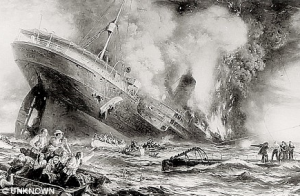 While Germany was willing to go to war, they had, nevertheless, a healthy fear of the United States. During World War I, Germany introduced unrestricted submarine warfare. It was early 1915, and Germany decided that the area around the British Isles was a war zone, and all merchant ships, including those from neutral countries, would be attacked by the German navy. That action set in motion a series of attacks on merchant ships, that finally led to the sinking of the British passenger ship, RMS Lusitania on May 7, 1915. It was at this point that President Woodrow Wilson decided that it was time to pressure the German government to curb their naval actions. Because the German government didn’t want to antagonize the United States, they agreed to put restrictions on the submarine policy going forward, which angered many of their naval leaders, including the naval commander in chief, Admiral Alfred von Tirpitz, who showed his frustration by resigning in March 1916.
While Germany was willing to go to war, they had, nevertheless, a healthy fear of the United States. During World War I, Germany introduced unrestricted submarine warfare. It was early 1915, and Germany decided that the area around the British Isles was a war zone, and all merchant ships, including those from neutral countries, would be attacked by the German navy. That action set in motion a series of attacks on merchant ships, that finally led to the sinking of the British passenger ship, RMS Lusitania on May 7, 1915. It was at this point that President Woodrow Wilson decided that it was time to pressure the German government to curb their naval actions. Because the German government didn’t want to antagonize the United States, they agreed to put restrictions on the submarine policy going forward, which angered many of their naval leaders, including the naval commander in chief, Admiral Alfred von Tirpitz, who showed his frustration by resigning in March 1916.
On March 24, 1916, soon after Tirpitz’s resignation, a German U-boat submarine attacked the French passenger steamer Sussex, in the English Channel, thinking it was a British ship equipped to lay explosive mines. It was apparently an honest mistake, and the ship did not sink. Still, 50 people were killed and many  more injured, including several Americans. On April 19, in an address to the United States Congress, President Wilson took a firm stance, stating that unless the Imperial German Government agreed to immediately abandon its present methods of warfare against passenger and freight carrying vessels the United States would have no choice but to sever diplomatic relations with the Government of the German Empire altogether.
more injured, including several Americans. On April 19, in an address to the United States Congress, President Wilson took a firm stance, stating that unless the Imperial German Government agreed to immediately abandon its present methods of warfare against passenger and freight carrying vessels the United States would have no choice but to sever diplomatic relations with the Government of the German Empire altogether.
After Wilson’s speech, the US ambassador to Germany, James W. Gerard, spoke directly to Kaiser Wilhelm on May 1 at the German army headquarters at Charleville in eastern France. After Gerard protested the continued German submarine attacks on merchant ships, the Kaiser in turn denounced the American government’s compliance with the Allied naval blockade of Germany, in place since late 1914. Nevertheless, Germany could not risk American entry into the war against them, so when Gerard urged the Kaiser to provide assurances of a change in the submarine policy, the Kaiser agreed.
On May 6, the German government signed the so-called Sussex Pledge, promising to stop the indiscriminate sinking of non-military ships. According to the pledge, merchant ships would be searched, and sunk only if they  were found to be carrying contraband materials. Furthermore, no ship would be sunk before safe passage had been provided for the ship’s crew and its passengers. Gerard was skeptical of the intentions of the Germans, and wrote in a letter to the United States State Department that “German leaders, forced by public opinion, and by the von Tirpitz and Conservative parties would take up ruthless submarine warfare again, possibly in the autumn, but at any rate about February or March, 1917.” Gerard was right, and on February 1, 1917, Germany announced the resumption of unrestricted submarine warfare. Two days later, Wilson announced a break in diplomatic relations with the German government, and on April 6, 1917, the United States formally entered World War I on the side of the Allies.
were found to be carrying contraband materials. Furthermore, no ship would be sunk before safe passage had been provided for the ship’s crew and its passengers. Gerard was skeptical of the intentions of the Germans, and wrote in a letter to the United States State Department that “German leaders, forced by public opinion, and by the von Tirpitz and Conservative parties would take up ruthless submarine warfare again, possibly in the autumn, but at any rate about February or March, 1917.” Gerard was right, and on February 1, 1917, Germany announced the resumption of unrestricted submarine warfare. Two days later, Wilson announced a break in diplomatic relations with the German government, and on April 6, 1917, the United States formally entered World War I on the side of the Allies.


Leave a Reply